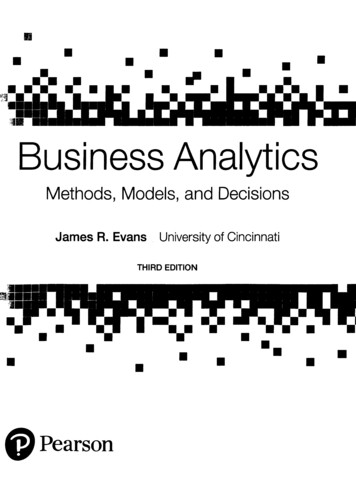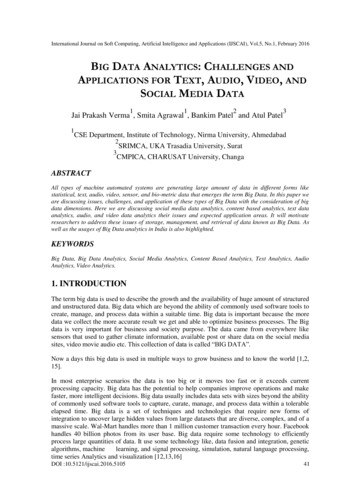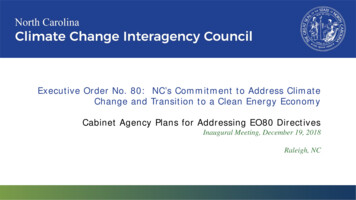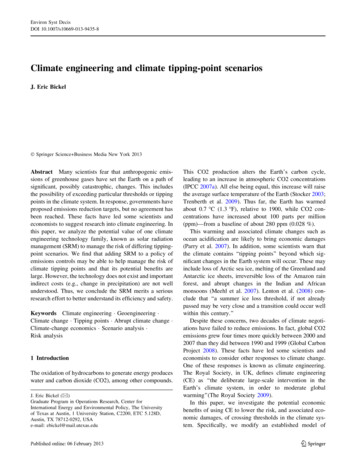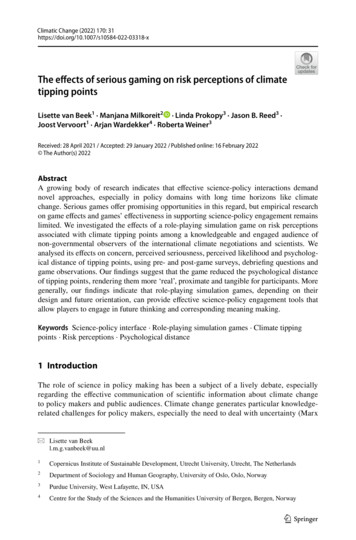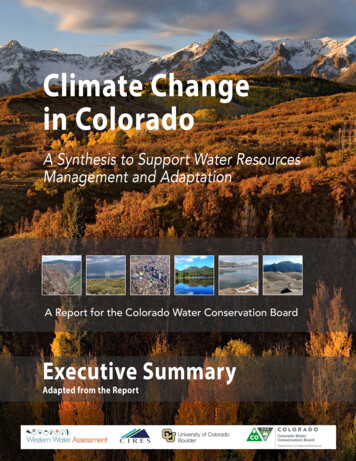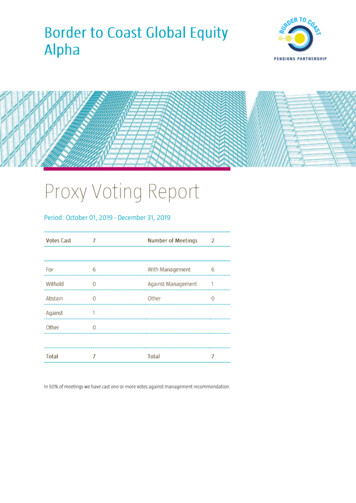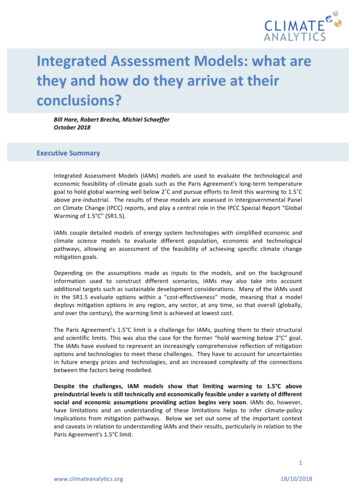
Transcription
Integrated Assessment Models: what arethey and how do they arrive at theirconclusions?Bill Hare, Robert Brecha, Michiel SchaefferOctober 2018Executive SummaryIntegrated Assessment Models (IAMs) models are used to evaluate the technological andeconomic feasibility of climate goals such as the Paris Agreement’s long-term temperaturegoal to hold global warming well below 2 C and pursue efforts to limit this warming to 1.5 Cabove pre-industrial. The results of these models are assessed in Intergovernmental Panelon Climate Change (IPCC) reports, and play a central role in the IPCC Special Report “GlobalWarming of 1.5 C” (SR1.5).IAMs couple detailed models of energy system technologies with simplified economic andclimate science models to evaluate different population, economic and technologicalpathways, allowing an assessment of the feasibility of achieving specific climate changemitigation goals.Depending on the assumptions made as inputs to the models, and on the backgroundinformation used to construct different scenarios, IAMs may also take into accountadditional targets such as sustainable development considerations. Many of the IAMs usedin the SR1.5 evaluate options within a “cost-effectiveness” mode, meaning that a modeldeploys mitigation options in any region, any sector, at any time, so that overall (globally,and over the century), the warming limit is achieved at lowest cost.The Paris Agreement’s 1.5 C limit is a challenge for IAMs, pushing them to their structuraland scientific limits. This was also the case for the former “hold warming below 2 C” goal.The IAMs have evolved to represent an increasingly comprehensive reflection of mitigationoptions and technologies to meet these challenges. They have to account for uncertaintiesin future energy prices and technologies, and an increased complexity of the connectionsbetween the factors being modelled.Despite the challenges, IAM models show that limiting warming to 1.5 C abovepreindustrial levels is still technically and economically feasible under a variety of differentsocial and economic assumptions providing action begins very soon. IAMs do, however,have limitations and an understanding of these limitations helps to infer climate-policyimplications from mitigation pathways. Below we set out some of the important contextand caveats in relation to understanding IAMs and their results, particularly in relation to theParis Agreement’s 1.5 C limit.1www.climateanalytics.org18/10/2018
The way IAMs are set up, mitigating climate change is always more expensive thaninaction. In general, IAMs do not include avoided negative externalities, such asdamages due to climate change or the cost of air pollution from the continued use offossil energy, so the net costs of meeting the Paris Agreement’s 1.5 C limit may be evenlower than the IAMs project. IAMs are designed to consider gradual changes to existing systems and are thereforenot very good at capturing rapid technological advances such as recent rapid advancesin deployment of solar photovoltaics and the decreasing costs of renewable energy andenergy storage, nor can they project the approach of systemic tipping points. Almost bydefinition, IAMs model established technologies and trends much better than newertechnologies, whose future political and technological pathways are harder to predict.Behavioural changes such as lowered meat consumption would have to be assumed asexternal inputs to the models. IAMs often tend to a conservative view of the potentialfor transformational change.Several recent IAM scenarios do explore assumptions and novel modelling ofdramatically lowered energy demand and increased energy efficiency related to lifestylechoices and large-scale deployment of new technologies beyond the energy sector,including information technology, urban development, sharing economies and healthierdiets, for example. These are also assessed in the SR1.5. Such IAM studies furtherstrengthen the already available evidence that energy demand and efficiency measures– partly available at net economic savings – are a crucial requirement for limitingwarming to 1.5 C, reducing the challenges faced by supply-side measures alone andsubstantially enhancing the overall feasibility and sustainability of achieving the 1.5 Climit. Many IAMs still include some carbon capture and storage (CCS) in their assumptions,despite the fact that this technology when deployed with fossil fuel power plant is nowwidely seen as a relatively expensive mitigation option with an uncertain future. The factthat CCS is not a zero emissions technology has important implications for natural gas inthe power sector, where many IAMs aimed at reaching close to zero global emissions inthe power sector by 2050 still include CCS. On-going reductions in renewable energyand storage costs also means the utilisation of natural gas for power production willlikely decrease below presently expected levels – and therefore present IAM modelsmay be overestimating natural gas markets. Equally, at present IAMs do not adequatelyrepresent the rapid electrification that is taking place across many sectors - such as inindustrial sectors such as steel production and the transport and building sectors. The change from internal combustion engines to electric vehicles is another example ofthe difficulty IAMs have in keeping up with changes in the real economy. The uptake ofEVs and renewably hydrogen-powered fuel cell electric vehicles (FCEV) in the privatetransport and freight sector is happening much faster than seen in the IAMs’ transportsector decarbonisation indicators. Bioenergy represents a key area of uncertainty in IAMs. Bioenergy is a renewableenergy resource. Using biomass to generate electricity and produce biofuels, togetherwith the capture and storage of resulting CO2 emissions, can result in net-negativeemissions, an important option for compensating remaining emissions from other2
sectors for which mitigation options may be limited, such as in agriculture required tofeed a still growing global population. However, there is a wide range of estimatesaround limits to the sustainable potential for bioenergy use. Many IAMs alreadyconstrain climate mitigation options by considering other sustainable developmentneeds such as food production and limiting biodiversity impacts. The complexity ofbioenergy options and their implications means that IAM scenarios need to besupplemented by follow-up analyses on more specific aspects and implications ofbioenergy deployment. Carbon Dioxide Removal (CDR) in IAMS. The two main CDR options represented in theIAMs underlying the IPCC 1.5 C Special Report are in the land sector – storing carbon inforests and soils via afforestation/reforestation – and, in the energy system, bioenergyin combination with CCS (BECCS). IAMs differ greatly in the extent to which CDR isimplemented, again depending on other assumptions made in the inputs to the models.Some IAMs include few constraints on the use of modern bioenergy, while others onlyallow for it after satisfying land demand for agriculture and food, and will not touch predefined biodiversity hotspots, natural forests and conservation areas. IAM CDR scenariosinclude land-use changes, such as reversing current worldwide net emissions due todeforestation toward increasing reforestation and afforestation, to help meet climatechange mitigation targets. The capacity for “nature based solutions” in meeting ParisAgreement targets is uncertain, but these can play an important role.The simplest summary of IAM outputs related to CDR is that the more quickly andcompletely decarbonisation and energy efficiency measures can be implemented andenergy demand limited, and the more rapid greenhouse gas emissions are reduced in allsectors, the less need will there be for CDR.Overall, while IAMs are one of the essential tools for policymakers to provide guidance ontechnically and economically feasible pathways to achieve specific climate and sustainabledevelopment goals, they are only one component of a toolbox of analytical tools andbroader considerations to be used in the evaluation of mitigation options to meet climatetargets.3www.climateanalytics.org18/10/2018
Full briefingIntroductionFor more than 20 years, energy, economy and climate models have played a central role inevaluating the technical and economic feasibility of climate targets. These are IntegratedAssessment Models (IAMs): they integrate knowledge from different domains into a singleassessment.In the context of the Intergovernmental Panel on Climate Change (IPCC) Assessments, IAMshave played an important role in framing questions around what is feasible, and what is not,in climate and energy policy terms.Research groups involved in integrated assessment modelling have played a significant rolein defining what policy scenarios can - and should - be modelled, and have responded toquestions from government and other stakeholders about the feasibility of limiting warmingto relatively low levels. The new RCP P1.9 scenario, which limits warming to about 1.5oC1,was developed after the adoption of the Paris Agreement.IAMs have the benefit of bringing the whole social economic system together and evaluatingdifferent population, economic and technological development pathways within aninternally consistent, science-based framework with a view to evaluating the feasibility ofdifferent climate and/or sustainable development goals. Many IAMs have developed insophistication and now include considerable technological detail and coupling betweendifferent systems, including land use, forestry and agriculture. Nevertheless, as with allmodels there are still significant limitations and caveats, some structural and otherscontingent upon scientific and technological development.The IPCC Special Report on 1.5 C, more than any previous IPCC report, is evaluating thetechnological and economic feasibility of limiting warming to 1.5 C. The energy modellingcommunity finds this level of ambition – while already quite risky for the global earth system- to be a challenge for their models. It pushes IAM models to their limits in both structuraland scientific terms. Under such a stringent climate target virtually every known option formitigation has to be deployed. Models are pressed to - in effect - “choose” between thetiming of deployment of options based on (future) energy price, and technologicalinformation that is inherently uncertain. And as with any mitigation pathway, there areimportant connections and synergies, both positive and negative, with sustainabledevelopment objectives.Evaluating the implications of mitigation pathways for sustainable development metricsoften relies upon post-processing of a model’s output. This includes, for example, cobenefits of mitigation such as reduced air pollution and improving human health andagriculture outcomes, which are not normally included in the model assessments, nor inestimation of the costs of mitigation.1Rogelj, J. et al. (2018) Scenarios towards limiting global mean temperature increase below 1.5C, Nature ClimateChange, doi:10.1038/s41558-018-0091-32Where countries committed to “Holding the increase in the global average temperature to well below 2 Cabove pre-industrial levels and to pursue efforts to limit the temperature increase to 1.5 C above pre-industrial4
The overall finding of the recent scientific literature on 1.5 C compatible pathways is thatthis goal is still technologically within reach under a range of different social, economic andpopulation assumptions. Not surprisingly, models find that the costs of limiting warming tothis level are higher than the cost for limiting warming to 2 C – as reported in the IPCC AR5.On the other hand, the IAMs considered here do not take into account the costs climatechange impacts, which will be higher for 2 C, nor economic benefits of reduced pollutionfrom fossil fuel use.This background paper is designed to lay out important context and caveats in relation tounderstanding IAMs and their results - particularly in relation to the 1.5 C issue as they willbe presented in the IPCC 1.5oC SR.Scientific backgroundIntegrated Assessment Models (IAMs) represent the coming together of three differentworlds of scientific thinking in relation to energy and climate science: energysystem/technological progress models, economic system models, and climate sciencemodels.Energy system models were historically focused on making prognoses about fossil fuel andnuclear power systems, and how issues of resource supply and societal demand wouldbalance out over time periods of a few decades, to several decades. In the context ofclimate change scenarios, these models have been adapted to provide more detailedmodeling of longer-term developments in regional and global energy systems.Economic system modeling is based on fundamental notions of how a market-basedeconomy functions, often starting with assumptions that world markets are in equilibriumand functioning efficiently, with perfect information available to all equally-placed actors.These models can take different assumptions on future foresight, from perfect over all timeforesight to what is called myopic, or short-term foresight.Climate science models, as used in IAMs, integrate the physics and chemistry of theatmosphere, carbon cycle and the ocean, in reduced complexity models designed totranslate greenhouse gas emissions and air pollutants to GHG concentrations, radiativeforcing and temperature, and other large-scale physical changes in the climate system.The core idea of IAMs is to capture the interactions between socioeconomic, technologicaland natural systems by combining simplified economic and climate models with moredetailed modeling of regional and global energy systems to make relevant projections of theconsequences of climate policy choices.Their scenarios describe an internally consistent and calibrated way for regional energysystems to get from current developments to meeting long-term global climate goals like1.5 C. Scenarios reflect a number of factors: regional diversity, (future) GDP and populationdevelopments, supply and demand of fossil fuel and renewable energy carriers,technological potentials and developments, structural change, autonomous and priceinduced energy efficiency changes, energy resources and reserves, inter-fuel substitutions,economies of scale, imports, exports, etc., all affecting prices and ultimately allowing us tofind an “optimal” prioritisation of mitigation options.5www.climateanalytics.org18/10/2018
From its starting point to end-of-century, a model deploys mitigation options in any region,any sector, at any time, so that overall (globally, and over the century), the temperature goalis achieved cost-effectively. This is why the outputs of these models are often referred to as“least-cost” pathways; as opposed to trying to compare costs and benefits of mitigationaction, the IAMs considered here taken a temperature limit as a given externally determinedparameter. However, the models also allow the assessment of a large variety of explicitconstraints that make their results more realistic or desirable in some way, for example byscaling up ambitious climate action in some regions with a delay compared to the costeffective solution, or by putting limits on the use of modern bioenergy.IAMs and the Paris AgreementSome background is needed to set the stage for placing IAM results in the context of theParis Agreement (PA)2. The specific PA limit on global temperature increase can be assessedby IAMs in terms of how to achieve this in a cost-effectiveness mode. Interestingly, manyIAMs of a previous modeling generation (from, say, 5-10 years ago) could not find withintheir own modeling structure economically viable solutions to limit warming to 2 or 1.5 C.As both scientific understanding of the impacts of different temperature changes have beenrecognised, and the sophistication of IAMs increased, more stringent limits have become“feasible.” IAMs are now able to trace out energy system transformation pathways that leadto 1.5 C-compatible scenarios. In addition, real-world developments such as decreasingcosts of renewable energy technologies have increased the palette of economically viablemitigation options. These changes in the ability of models to find cost-effective solutions toachieve climate goals represent an interesting and cautionary dynamic. Models of any kindare only as good as their input assumptions, from those about up-to-date technological andmarket developments to the more fundamental questions of how “rational” people andgovernmental policies will be.Given this introduction, what do IAMs now tell us in more detail about the potential forachieving the PA goals? We illustrate how IAM results can be understood by discussing fivepertinent topics.1. Economic costs of mitigationStarting with the “rational” assumption that the economic system is already in an optimumstate, at least for the sake of argument, IAMs first determine the “business-as-usual”pathway for different future scenarios of socioeconomic development.Then, by changing to a lower “allowed” total carbon budget, lower greenhouseconcentrations reached by end of century, or by setting a carbon price on carbon dioxideemissions, the model calculates the optimal, least-cost pathway from the business-as-usual,or reference case, under these new constraints.By definition, this method with these models will always find that the new situation (e.g.Paris Agreement target) costs more than “business-as-usual.” We know that economicrationality is not universally the case – for example while it is not economically efficient for2Where countries committed to “Holding the increase in the global average temperature to well below 2 Cabove pre-industrial levels and to pursue efforts to limit the temperature increase to 1.5 C above pre-industriallevels, recognising that this would significantly reduce the risks and impacts of climate change.”6
governments to subsidize the extraction and use of fossil fuels, in reality, they do. At thesame time, it would be economically rational for governments, or more generally, idealmarket-based mechanisms, to add the negative external costs of fossil fuel consumption(e.g. air pollution costs, environmental damages) to the price consumers pay for energyfrom these sources; again, for the most part, they do not.IAMs do not usually take either of these factors sufficiently into account. Even so, IAMs findthe costs to get onto a Paris Agreement pathway are quite low - a fraction of a percentagepoint of GDP per year. In the case of 2 C targets reported in AR5, the average was0.06%/year – barely distinguishable from the noise of real-world GDP fluctuations.Recent IAM pathways (Rogelj et al 2018) find time-averaged discounted reductions in globalGDP associated with mitigation measures for 1.5 C (compared to a no-climate-policybaseline) to be three times higher than for 2 C in the long term. GDP losses would be threeto four times higher in the next few decades due to the greater need for rapid, near-termreductions in 1.5 C pathways. These GDP losses would still be very small compared toprojected overall GDP growth. Also, they do not account for larger and earlier benefits of1.5 C compared to 2 C in terms of the reduced climate change damages – or the larger cobenefits from lower pollution related to fossil fuel extraction and use.2. 1.5 C pathways under the recent and continuing drop in the price ofrenewablesIAMs have a difficult time projecting emissions pathways for a future of dramatic changes.This is not surprising, as such changes are almost by definition surprising and rapid, and areoften recognised only in hindsight as having been a true transition. If government policies orpersonal preferences nudge behavior toward a “tipping point”, a rapid change in energyconsumption could be possible, one that would be difficult to replicate in IAMs that arepredicated on slow, smooth, marginal changes.For example, IAMs have been “surprised” in recent years by the dramatic costimprovements of renewable energy technologies compared to fossil fuels. A large part ofthis cost development has been due to behavior by consumers, and by governmentsdeciding that more solar panels, wind turbines and, more recently, batteries and electricvehicles, would be a good long-term policy to support – not because those actions wereinherently the most rational and optimal decisions. The resulting sharp increase ininstallations and purchases induced both learning and scale effects that drove down costs,making further installations even more attractive – a “virtuous cycle”.In fact, IAMs are beginning to find solutions that are optimal under the conditions of themodel over the long-term and that move toward much higher shares of renewables inelectricity than was the case even a few years ago, with results in the most recent modelsreaching 60-80% non-biomass renewable electricity by 2050.Whereas 2 C scenarios at the time of IPCC’s Fifth Assessment Report (2014) projected thatabout 5-17% of global electricity supply would be covered by solar PV by mid-century,Creutzig et al (2017) explicitly updated an IAM with the very recent drop in solarphotovoltaics (PV) prices. They showed that the updated projections lead solar PV meeting30-50% of global electricity generation by mid-century –assuming further advances insystem integration of renewables. Bottom-up sectoral studies still generally find even7www.climateanalytics.org18/10/2018
stronger emissions-reduction potential at the same or lower cost for the near term thanrealised in IAMs (UNEP 2017).3. Fossil fuel phase out and CCSUnsurprisingly, the difference between 2 C and 1.5 C scenarios is that the 1.5 C scenariosrequire an even more rapid decarbonisation of the energy system, with global zero CO2emissions being achieved around the 2070s with 2 C, but around the 2050s for 1.5 Ccompatible pathways, with coal phased out even earlier (before 2050) than other fossilfuels.In IAMs, a new technology is scaled up most easily if it is very similar to older, knowntechnologies and, in this context, to many in the modeling community adding carboncapture and storage (CCS) to fossil fuel power plant appeared to be a more logical and costeffective step for the model than a change to a new technology, such as utility scale PV oreven massive deployment of distributed rooftop solar photovoltaics (PV).In this context, many IAMs produced results that indicated CCS from fossil fuels powerplants were a very promising option. In practice, however, the costs of this technology werehigher than estimated and its feasibility proved more difficult: progress towardcommercialising the technology has been much slower than projected ten years ago. As aconsequence, fossil CCS is now widely seen as a relatively expensive mitigation option withan uncertain future. However, many IAM models have continued to deploy this technologyfor fossil fuel power plants at large scale over the 21st century in both 1.5 C and 2 Cpathways. Model deployment of fossil CCS is lower in 1.5 C pathways as it is not a zeroemissions technology and is estimated to achieve only 85-95% reduction when 100%reductions are needed by 2050.This has important implications for policy, for example with natural gas in the power sectorand undermines the commonly-advanced argument that gas is a bridging fuel. It is quitecommon to see natural gas deployed in the IAM model assessments aimed at reaching closeto zero global emissions from the power sector by 2050; however, in such pathways naturalgas is often accompanied by deploying CCS. As renewable sources of power increase inscale, the utilisation rate of natural gas power plants decreases, making the addition of CCSan even more expensive proposition.Given the recent developments in renewable energy and storage technologies, some ofwhich have yet to be included in state-of-the-art IAMs, it would seem unlikely that CCS couldbe economically deployed for natural gas power turbines, with the implication that presentIAM models may be overestimating future natural gas markets for the power sector.Another important factor is that at present IAMs do not adequately represent the rapidelectrification across many sectors that seems increasingly plausible to many analysts,particularly in industrial sectors such as steel production, in the transport sector (see below)and in the buildings sector (Kriegler et al 2018; Grubler et al 2018). Implementation of theassociated technologies would allow for an even more rapid phase-out of fossil fuelemissions, without relying on CCS.4. Uptake of electric vehicles – electrification of transportThe change from internal combustion engines to electric vehicles are another example ofthe difficulty IAMs have in keeping up with likely changes in the structure of the complex8
world energy system. In a parallel with renewables in electricity generation, the uptake ofEVs and renewably hydrogen-powered fuel cell electric vehicles (FCEV) in the privatetransport and freight sector has recently been faster than expected, and is expected tospeed up in the coming decades. This is all happening much faster than in the IAMs’transport sector decarbonisation indicators.IAMs try to capture a change in the transportation system where low-carbon alternativessuch as biofuels, hydrogen and electric vehicles displace internal combustion enginevehicles. The technological change is reflected in a gradual decrease in consumption of oil(thus decreasing CO2 emissions), coupled with an increase in the use of biomass andelectricity. However, what the models don’t usually capture well - if at all - would be theanswers to questions such as “what will the share of electric vehicle sales be in 2030?” or“how many EV charging stations must China build by 2030 to support the electrification ofpersonal vehicle transportation?”Finding details of pathways within individual sectors that might still be compatible with theoverall global, Paris Agreement-compatible total emissions profile requires an additionaleffort of downscaling the high-level results of IAMs, while also taking into accountdevelopments that have made faster progress than initially anticipated.5. Demand-side and energy efficiency measuresTraditionally, supply-side management of the energy system is represented at the highestlevel of detail in IAMs and, alongside technological energy efficiency improvements thatlower energy demand, is their strongest aspect. Less well covered by IAMs, and thereforeless represented in the scenarios they produce, are fundamental interventions on thedemand side, which were usually explored through simplified variations in underlyingassumptions.This is starting to change, however, with some of the recent publications covered in the IPCCSpecial Report on 1.5 C. These explore elements and synergies related to, for example,behavioral changes and lifestyle choices, leading to fundamental shifts in transport modes,in diets towards low meat consumption, or low population growth (van Vuuren et al 2018,Grubler et al 2018).These variations generally facilitate a more rapid near-term decarbonisation, enhancesustainability synergies of 1.5 C pathways and may lower the need for Carbon DioxideRemoval (see next section), with the caveat that the authors cited above do not necessarilydeem it plausible that all such changes would materialize simultaneously to the extent themost far-reaching of these scenarios assume.6. Carbon Dioxide RemovalAs a final example of IAM output we look at the question of Carbon Dioxide Removal (CDR),or negative emissions. The need for negative CO2 emissions arises for several reasons. First,today’s high CO2 concentrations from historical emissions mean that we need extreme ratesof CO2 emission reductions to halt the rise in CO2 concentration. To reduce CO2concentrations in order to meet the Paris Agreement’s temperature limit, we will have totake some CO2 out of the atmosphere.9www.climateanalytics.org18/10/2018
Second, there are significant non-CO2 greenhouse gas emissions that are difficult to reduce,notably from agriculture and some industrial sources. For example, a growing populationmeans it will be quite a challenge to just stabilize non-CO2 emissions from agriculture in thenext few decades. Reducing more non-CO2 greenhouse gas emissions will require fewernegative CO2 emissions, and vice versa.Thirdly, we cannot just switch energy systems overnight, and significant time will be neededto move to a low carbon energy system. The faster we can do this, the more we can reducethe need for negative CO2 emissions, and conversely, the slower our action, the greater theneed for negative CO2 emissions.Taken together, it is very difficult to see how CDR can be completely eliminated from the mixof climate change mitigation options and still achieve the PA target.The two CDR options represented in the IAMs underlying the IPCC 1.5 C Special Report arein the land sector – storing carbon in forests and soils via afforestation/reforestation,including ecosystem restoration – and, in the energy system, bioenergy in combination withCCS (BECCS). In typical scenarios, these are roughly deployed in equal measure, except withscenarios that reach very high levels of CDR, exhausting the limited potential ofafforestation/reforestation.IAMs differ greatly in the extent to which CDR is implemented, again depending on otherassumptions made in the inputs to the models (such as population size and socioeconomicconditions), and in the expected speed of transformation in socioeconomic andtechnological trends represented in the models.For example, some IAMs include few constraints on the use of modern bioenergy, whileothers only allow for it after satisfying land demand for agriculture and food, and will nottouch pre-defined biodiversity hotspots, n
on Climate Change (IPCC) reports, and play a central role in the IPCC Special Report "Global Warming of 1.5 C" (SR1.5). IAMs couple detailed models of energy system technologies with simplified economic and climate science models to evaluate different population, economic and technological



